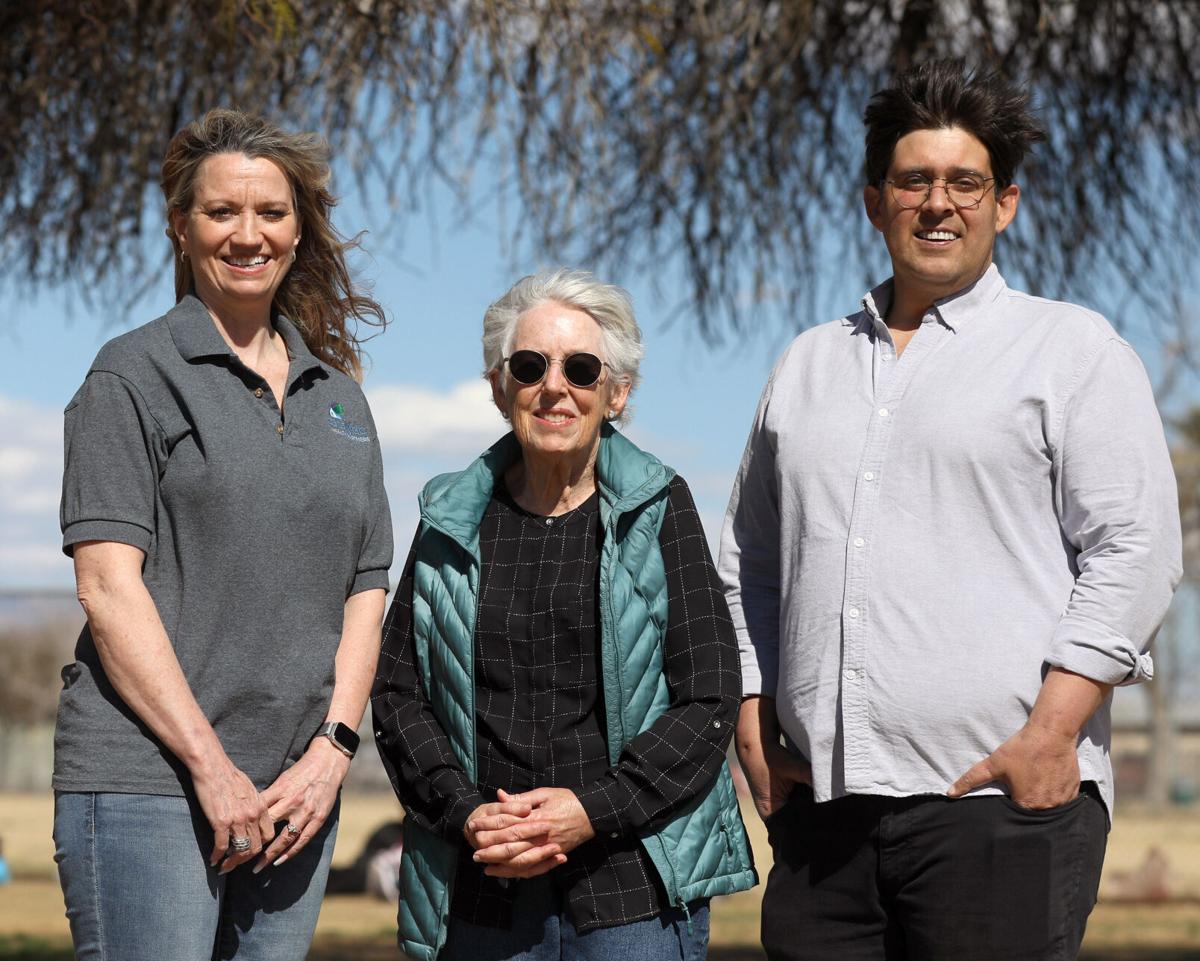Dozens of unsheltered people in Santa Rita Park did their best to seek refuge from the sun on a day Tucson's temperatures peaked at 87 degrees. They huddled under trees, tents, umbrellas and anything else that provided shade.
The scene is similar at parks across the city. Soon, the temperatures will become dangerous for people who live on the streets. City officials say the number of people lacking a place to live in Pima County in 2021 was estimated to be 135% higher than it was just three years before.
In 2018, there were 1,380 people experiencing homelessness in Pima County, 363 of whom were unsheltered, data presented during a recent Tucson City Council meeting showed. In 2021, the figure rose to 1,675, with 854 people estimated to be unsheltered.
One local nonprofit has what it believes could be a piece of the solution, and it's a model that has already piqued city officials' interest in Tucson and beyond: a secure, micro-house village with wraparound medical, behavioral health and social support for residents.
The Homing Project, started in 2021 by a former El Rio doctor and her son, who has experience working with similar projects in Southern California, has the plan — and soon, the funding. But they're missing one critical piece: land that can be used for the next several years.
"A desperate need for this"
Dr. J. Kristin Olson-Garewal and her son, Raj Garewal, formed The Homing Project in August of 2021, based on a Pallet shelter model that's used in 55 cities across the country, but mostly in Southern California. Pallet, a social purpose company, originally built disaster shelters, but communities across the country have been using Pallet's tiny homes for years to quickly get people off the streets and into secure, stable housing.
They've been used in cities like Tacoma, Washington; Chico, California; Aurora, Washington; and dozens more.
Pallet houses, which come in 64- and 100-square-foot models, can be assembled quickly and house two beds, a desk and room for storage. The beds fold up, to help maximize space, and each unit includes electricity, heating and air conditioning. The transitional homes are secure, with locking doors, and offer on-site social services, food, restrooms, showers and laundry.
Olson-Garewal, who was a doctor for 45 years and served as medical director for the state's Medicaid program, the Arizona Health Care Cost Containment System, likened the smaller models to freestanding dorm rooms. The larger, 100-square-foot homes would be able to house a family of four, she says.
"There's a desperate need for this," Olson-Garewal said. "We've been trying to get a land donation, but we talked to the city and they said there's no land."
The Homing Project initially had someone offering to donate land. But with real estate prices soaring, that person ended up selling it instead.

"We looked at buying land instead, but we're amazed at how expensive it is," Olson-Garewal said, adding that if they have to, they'll buy the land themselves, but they're hoping someone will come forward with an option to lease.
During the Feb. 8 City Council meeting, city leaders discussed several strategies already underway and being explored to combat homelessness, including using federal pandemic relief funds to increase permanent and transitional housing. With community shelters dropping their capacity 25% in 2020 because of COVID-19 and many still facing staffing challenges, the University of Arizona's Southwest Institute for Research on Women estimated a need of 2,000 housing units to reach a "functional zero" in terms of unsheltered people.
The city is already considering creating its own Pallet shelter village, as housing and development director Elizabeth Morales discussed during the meeting the idea of a 45-shelter Pallet village that would house 70 to 90 adults for an estimated cost of $1.45 million.
One of the benefits of the Pallet homes, aside from their cost — which starts at $5,550 for the smaller model — is that they can be disassembled and relocated up to 40 times and have a 10-year lifespan, Morales said, estimating delivery and installation at two to three months.
In January, The Homing Project submitted its proposal for a Pallet house village, applying for one of the city's American Rescue Plan Act grants to cover a 14-unit portion of a village. Olson-Garewal said the ultimate hope is for a 30-house village, but the city's criteria included only proposals for transition housing for youth and elders.
They're currently in the second phase of a three-phase review process and are hoping to receive roughly $186,000 in funding. While the funding will be a big help, the project needs a location to move forward.
"Opportunity to have a voice"
Each year, the Tucson Pima Coalition to End Homelessness conducts a point-in-time count of the area's homeless, including people in and out of the shelters. But because of the pandemic, the count hasn't taken place since 2020. The Tucson Police Department's Homeless Outreach Team has been conducting unofficial counts to try to gauge the situation.
Morales, the housing director, said during the Feb. 8 meeting that there are up to 259 encampments throughout the city.
"It took everyone's breath away. We knew it was a lot, but that was a bit much," Olson-Garewal said. "The biggest reason for homelessness isn't addiction or mental illness, it's that there aren't places for people to live. There's been a decrease in building of affordable units."
Another benefit of Pallet houses is how little space is required to set up a village, Olson-Garewal said. The Homing Project can fit 30 homes on an acre of land, and they estimate that it will take two to three years to get most people transitioned into permanent housing, allowing time for the housing market to stabilize.
The Homing Project already has an order in with Pallet for 34 homes, with four to be used as offices for wraparound services through a partnership with Catalytic Health Partners, an Arizona company that's been working in the area of housing for the past seven years. Catalytic works with people who tend to overutilize traditional medical services, primarily due to homelessness.
"We'll find them a home, arrange for services and help them get a job, if appropriate," Olson-Garewal said.
Catalytic's CEO, Susan Cordts, is happy to be along for the ride, saying she's been working to try to get tiny or micro-houses off the ground in Pima County for the past five years.
Cordts met Olson-Garewal through her work at St. Francis Men's Shelter, where she's been collaborating for a few years. A St. Francis employee told her about The Homing Project and the struggles it was having moving forward, and Cordts knew the pairing would be a perfect fit.
"Community-based health care is about meeting people where they're at," Cordts said. "People need to be empowered if we want them to make changes in their lives and their health. That needs to start with them being empowered."
While Catalytic will have office space at The Homing Project's future site, the idea will be to visit people in their own homes, helping providers get a full picture and the best possible context of the patient's living situation.
"It levels it out for people to have a bigger voice and share more openly about what's really going on in their lives and about the barriers that hinder them moving forward," Cordts said. "This makes the providers more socially aware of what's going on with an individual, as problems are often masked when people show up at their office."
Cordts used the example of a person who is unhoused being able to shower and get a new set of clothes at a shelter before visiting a doctor. This doctor might give the person advice about a new diet that they think could make a positive impact without being aware of the person's living situation or struggles.
"People don't show up in a clinic and say, 'I'm homeless and struggling and I can't afford the food you want me to eat and the things you want me to do,'" Cordts said. "You have to give people an opportunity to have a voice and make it happen and not have to ask so many questions."
Cordts said The Homing Project's forward progress is a sign of local leaders changing the way Tucson houses and supports the homeless, and something the community needs and deserves.
"It's not a tent, or a bed in a huge building somewhere where they don't have anything to take care of that's theirs," she said. "This is theirs. Their house, their key, their lock, their stuff, their lives."
Busy applying for other grants
While Olson-Garewal is hopeful that The Homing Project's ARPA grant application will make the cut, she and son Raj Garewal are still busy applying for other grants and seeking out donors.
They're also looking for land, and as Olson-Garewal is aware that this will likely become a "not in my backyard" issue and many people will not be keen on the idea of the Pallet house village moving into their neighborhood, they're looking for land in nontraditional areas away from neighborhoods.
The ideal site would be near an industrial area, close to a bus line so people can get around. In addition to Catalytic's on-site services, The Homing Project has also partnered with a local dentist to set up a clinic that will be open to not only residents, but also people from other facilities who need services.
"We're trying to locate far enough away that no one will be upset," Olson-Garewal said. "Once we have a site, we'll go around and talk to people and invite them to take part in running the place and getting to know the residents."
The village will be fenced and have on-site security, and while residents will be allowed to come onto the property drunk or under the influence, no illicit substances will be allowed on the premises.
"The only thing that will get people tossed out will be violence," Olson-Garewal said.
Residents who work will pay "appropriate rents" after six to 12 months, as the project will be providing electricity and paying the water bill, which will give the resident a track record as a renter. They're applying for grants to get solar power set up to cut down on the electric bill, and the group will hire a chef to organize a crew of residents who will take turn making their own meals and handling cleanup.
Olson-Garewal has also been busy the last several months having conversations with unsheltered people to assess what kinds of services they'll need on site. That's where the idea for dental came from, after the first person she met with kept covering up their mouth.
"Pallet houses are the quickest way to do this. It's not just a matter of getting people off the streets and treated for mental illness," she said. "It has to be a house that can last. And you have to have the support of the City Council, because people will come forward and object to it."
Raj Garewal will be in charge of the day-to-day operations, using his lived experience to work directly with residents. Olson-Garewal will handle the business and grant side of the project.
Olson-Garewal says the group is prepared to buy the land if it comes down to it and they can find an affordable plot, but ideally they could just have use of someone else's land and pay rent for the next five to 10 years.
"The biggest kink is the land," she said. "We just need level ground on some dirt."
For more information or to donate to The Homing Project, visit thehomingproject.org.






